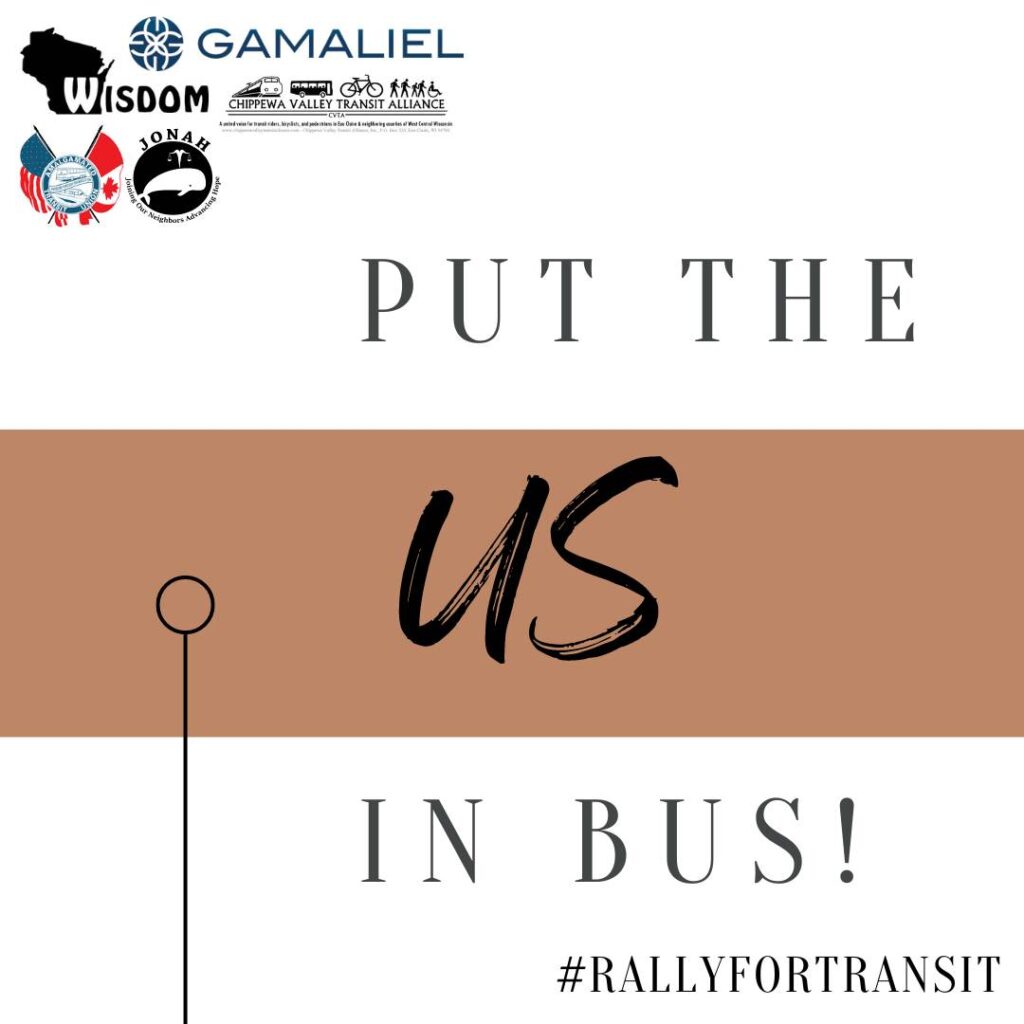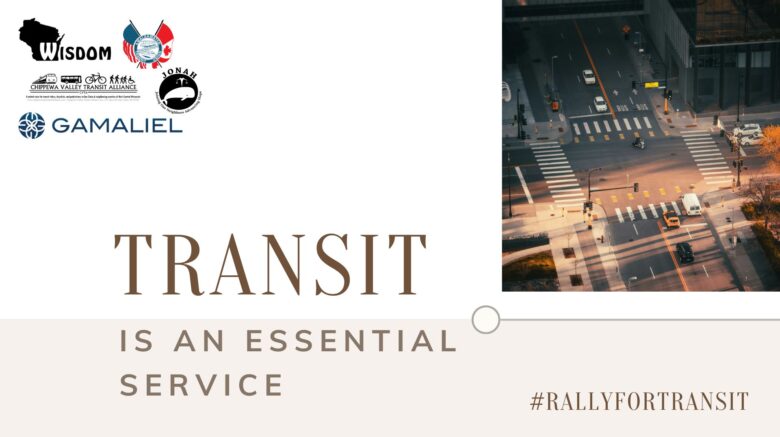Thursday, July 25, 2024 | 4:30pm @ Wilson Park, Eau Claire
Read John Wagner’s post-rally summary here.
Read Susan Wolfgram’s article on how transit is an essential service here.
Why rally for transit? What is RTA?
Our purpose is to increase awareness in our community and with legislators that transit is a tool for equity in a community and that all modes of public transportation are essential services. We will lift up the need for expanded services and a Regional Transportation Authority (RTA)* for the entire Chippewa Valley.
*The term “RTA,” commonly known as a Regional Transportation Authority, is a local or regional governmental entity or agency that provides public regional transportation including various modes such as bus transit, commuter rail, light rail, bus rapid transit, or others. An RTA is typically funded through local, county, state, and federal funding agreements. Some RTAs are self-governing, and some have taxing authority. Passing RTA legislation allows an entity to be created that can create its own local fundraising system.
JONAH Task Forces all agree: “Transit is an essential service!”
Transportation: Access to good public transportation is an essential service that provides mobility for individuals who need access to healthcare, employment, government services, grocery stores, retail stores, etc. Lack of essential public transportation places burdens on those who are economically disadvantaged and degrades the overall quality of life and well-being of the community in which people live.
Environmental: When it comes to climate change and sustainability, transportation plays a big part. As we saw during COVID, when less people drive their cars, the air quality improves. The Environmental Task Force supports alternative modes of transportation through public transit, walking, and biking.
Child Poverty: Public transport is the only transportation for many low-income families’ access to food, health care, and education.
Affordable Housing: Housing represents more than just the structures themselves. Its connection to convenient and reliable transit networks provides residents access to employment, services, and the amenities of daily life. Equitable transit-oriented development includes affordable housing, and it is built around the actual needs of the people who use the transit system. Robust public transit is an important complement to affordable housing. By facilitating dense, well-connected development, low-income residents can live in opportunity-rich areas without incurring the costs of car ownership.
Chippewa Valley Justice Action Team: Transportation is an essential service for the individuals the CVJAT works with and walks alongside, as it provides critical support to individuals impacted by the criminal justice system, including those in recovery and those reentering society after incarceration. Reliable and affordable transportation is essential for accessing employment opportunities, healthcare, educational programs, and social services, all of which are vital for successful reintegration. It enables individuals to attend job interviews, medical appointments, and legal obligations, and to reconnect with their families and communities. For the CVJAT, transportation is crucial to ensuring individuals can overcome barriers, achieve stability, and contribute positively to society, ultimately fostering a more inclusive and equitable community.
Immigration: If you grew up in the midwest, it’s hard to imagine not being able to jump in your car and get where you need to go. But for many of our neighbors from other countries everything is new. There is no car until you have work and a license, and that takes time. As a new community member without a driver’s license, having an affordable efficient daily transit system is vital.
Mental Health: There are a broad range of things that impact one’s mental wellbeing, and stress is a large contributing factor. The stress of not being able to get to where you need, and the stress of feeling unwelcome or judged when you go somewhere impact your ability to function at your best. Having easy access to welcome public transportation removes an entire level of stress from people’s lives – ensuring that their work, errands, and wherever else they need to go runs smoothly. This sets them up for success in their day. In regards to mental illness, those struggling may not be able to drive at all and public transportation helps connect them to their appointments and keeps them functioning in society in a way that is safe and welcoming for them.
Transit Data
Access to Jobs: According to a 2013 study conducted by the Board of Governors of the Federal Reserve Bank, “inadequate public transit and car affordability emerged as significant barriers to attaining and maintaining employment.” Without reliable transportation, employees may be limited to working certain shifts, may not show up to work on time, or may not be able to show up at all.
Access to Healthcare: In 2017, approximately 5.8 million people living in the United States missed or delayed essential, non-emergency medical care because of transportation barriers, with the chronically ill, women, veterans, the elderly, Black, brown, and indigenous people, and low-income individuals facing the largest transportation burdens.
Safety: Overall, bicycle and pedestrian fatalities are on the rise in the United States. In the past decade, the number of people struck and killed by a car, truck, or bus while walking increased by 35%.
Access to Physical Activity: A Bridging the Gap study of income disparities in street features that encourage walking found that streets with street and/or sidewalk lighting, traffic calming, and marked crosswalks were significantly more common in higher-income communities than in middle- and low-income communities.
Community Perspectives on Transit
Adam, Bus Driver for 2 years: Do you think that spending money on transit is a good investment for our community? “I do. Especially when you deal with the passengers, and you see them and they go to work day in and day out. Same passengers usually every day, so you build a rapport. It’s a service we provide so that people can get to places they need to, and they can’t necessarily afford a car.” Is there anything that you would change [about transit]? Getting more passengers to ride the bus, getting people over that fear of who are they going to meet on the bus. “Am I going to like that person?” That kind of thing.
Haven House Interview: “I haven’t used the bus since December. It’s nice to know I have a backup. It takes a lot of time out of my day. Making sure I have the right bus and times. Sometimes the times aren’t very accurate. […] Difficulties getting around really depends on the time of day and the week. [… The best part is] all the different options I have.”
Matt, Bus Driver for 4.5 years: “I enjoy meeting people. I enjoy the regular patrons. We have the regular customers, passengers. I enjoy it. […] I’m very appreciative for my job.” How do you drivers manage to stay so happy and nice all day long? “Everybody has a bad day. You got to be understanding.”
Haven House Interview: “I use the bus system a lot and it works for me. It makes stops at all the hot spots, and the cost is affordable. The free bus passes are really nice for me. They give them out often enough.[… Public transportation is essential] for a lot of people. If you can’t drive or get around, it is really needed for a lot of people. […] It’s a really good system for such a smaller area.”
Josh, Bus Driver for 16 years: “I’d like to see the bus service continue – maybe be expanded a little bit for transit to move forward in the city in the future.”


